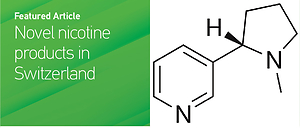New products, such as Puff Bars and nicotine pouches are widely available in Switzerland, as there is still no age limitation for the sale of tobacco and nicotine products at a national level in Switzerland, with only seven Cantons having banned the sale of nicotine to minors. In addition to that, these new products are cheap, appeal to youth and allow a hidden and stealthy consumption1,2. Following the arrival of Puff Bars in Switzerland in 2020, the flood gates were opened and now we find new brands, providing disposable ENDS, entering the market every week. These disposable ENDS are mostly sold on the internet, and we saw, an explosion of on-line shops for tobacco and nicotine products throughout the COVID-19 pandemic (we estimate to have between 220 and 250 such online shops currently active in Switzerland). As online sales of disposable ENDS remain significant, we continue to find these products in vaping shops, classical tobacco shops, and in highway or railway station shops. Unfortunately, we have no data on the volumes and sales, so we cannot follow the evolution of this market3. In Switzerland, the market of disposable e-cigarettes is projected to increase by 2200% in 20224.
A standard Puff Bar allows you to ‘puff’ 400 times, which is equivalent to 30 cigarettes. The stronger products allow you to even ‘puff’ up to 4000–5000 times, which is equivalent to over 400 cigarettes5. Prices are comparatively much cheaper than cigarettes. Synthetic nicotine has been found in Puff Bars since April 2021 and no longitudinal studies are yet able to adequately describe its health or neurological impact6. Most, if not all, disposable ENDS are produced in China (in an online shop selling a very broad variety of Chinese products for export in large quantities, we found over 400000 different disposable ENDS). The arrival of synthetic nicotine is thus certainly an important issue. Moreover, we simply have no idea about what exactly is in those products and there is no effective control on what is entering our markets.
Another issue is the lack of surveillance data. There are insufficient, consistent data in Switzerland, and more generally in Europe, on the consumption of new products by youth. Some products are very new and very recent on the market. Most available research on ENDS consumption in youth is based on data collected before the arrival of Puff Bars on the market7,8. Today asking a question such as ‘do you vape or consume e-cigarettes?’ to a teenager, lacks detail and relevancy. In future surveillance, we will have to be able to differentiate between several products (different generations of ENDS, HTP, nicotine pouches, waterpipes, etc.). But it is not only a refined consumption surveillance that is lacking. We also need to urgently generate more relevant, behavioral surveillance, in particular Knowledge, Attitude, Practice and Behavior (KAPB) research on the consumption of new products amongst youth.


